fuel pressure CHEVROLET OPTRA 5 2007 1.G Owners Manual
[x] Cancel search | Manufacturer: CHEVROLET, Model Year: 2007, Model line: OPTRA 5, Model: CHEVROLET OPTRA 5 2007 1.GPages: 422, PDF Size: 2.39 MB
Page 134 of 422
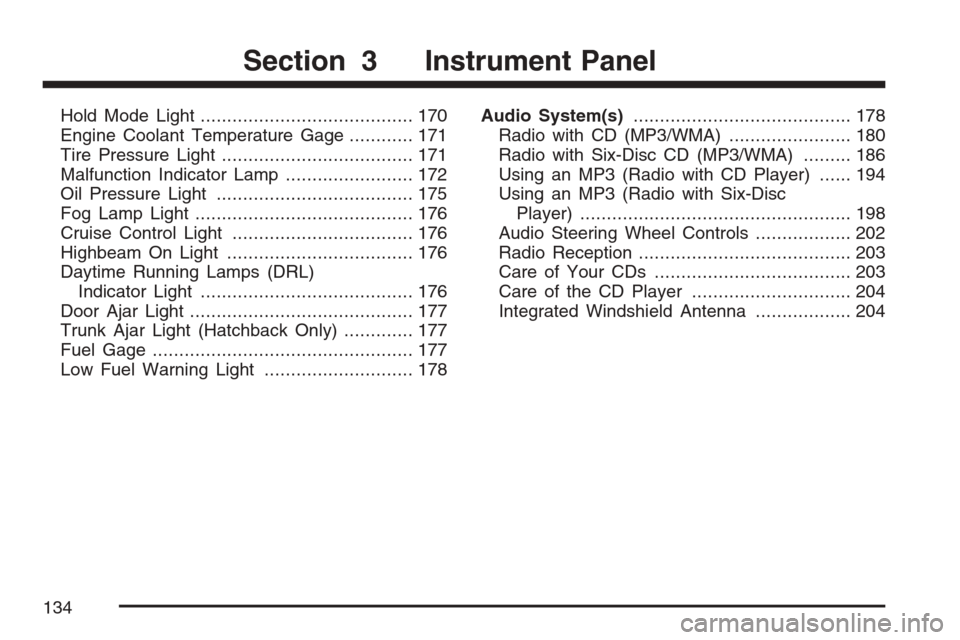
Hold Mode Light........................................ 170
Engine Coolant Temperature Gage............ 171
Tire Pressure Light.................................... 171
Malfunction Indicator Lamp........................ 172
Oil Pressure Light..................................... 175
Fog Lamp Light......................................... 176
Cruise Control Light.................................. 176
Highbeam On Light................................... 176
Daytime Running Lamps (DRL)
Indicator Light........................................ 176
Door Ajar Light.......................................... 177
Trunk Ajar Light (Hatchback Only)............. 177
Fuel Gage................................................. 177
Low Fuel Warning Light............................ 178Audio System(s)......................................... 178
Radio with CD (MP3/WMA)....................... 180
Radio with Six-Disc CD (MP3/WMA)......... 186
Using an MP3 (Radio with CD Player)...... 194
Using an MP3 (Radio with Six-Disc
Player)................................................... 198
Audio Steering Wheel Controls.................. 202
Radio Reception........................................ 203
Care of Your CDs..................................... 203
Care of the CD Player.............................. 204
Integrated Windshield Antenna.................. 204
Section 3 Instrument Panel
134
Page 228 of 422
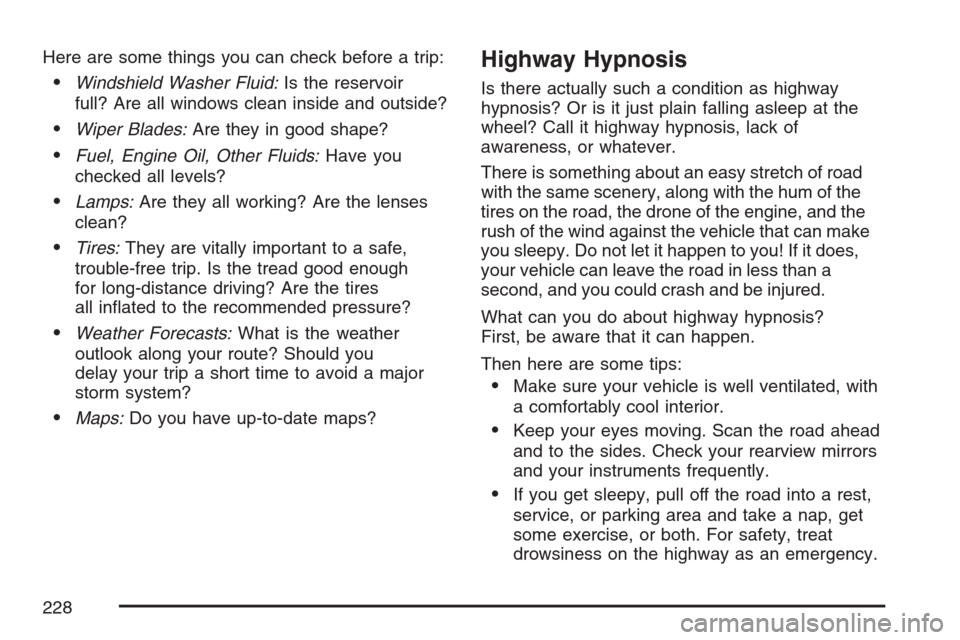
Here are some things you can check before a trip:
•Windshield Washer Fluid:Is the reservoir
full? Are all windows clean inside and outside?
•Wiper Blades:Are they in good shape?
•Fuel, Engine Oil, Other Fluids:Have you
checked all levels?
•Lamps:Are they all working? Are the lenses
clean?
•Tires:They are vitally important to a safe,
trouble-free trip. Is the tread good enough
for long-distance driving? Are the tires
all inflated to the recommended pressure?
•Weather Forecasts:What is the weather
outlook along your route? Should you
delay your trip a short time to avoid a major
storm system?
•Maps:Do you have up-to-date maps?
Highway Hypnosis
Is there actually such a condition as highway
hypnosis? Or is it just plain falling asleep at the
wheel? Call it highway hypnosis, lack of
awareness, or whatever.
There is something about an easy stretch of road
with the same scenery, along with the hum of the
tires on the road, the drone of the engine, and the
rush of the wind against the vehicle that can make
you sleepy. Do not let it happen to you! If it does,
your vehicle can leave the road in less than a
second, and you could crash and be injured.
What can you do about highway hypnosis?
First, be aware that it can happen.
Then here are some tips:
•Make sure your vehicle is well ventilated, with
a comfortably cool interior.
•Keep your eyes moving. Scan the road ahead
and to the sides. Check your rearview mirrors
and your instruments frequently.
•If you get sleepy, pull off the road into a rest,
service, or parking area and take a nap, get
some exercise, or both. For safety, treat
drowsiness on the highway as an emergency.
228
Page 245 of 422
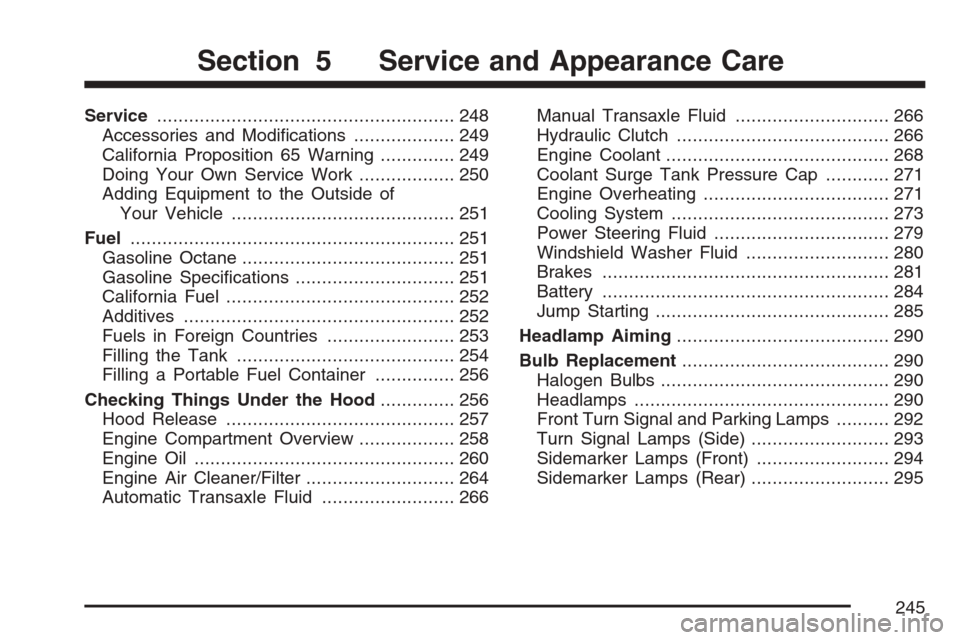
Service........................................................ 248
Accessories and Modifications................... 249
California Proposition 65 Warning.............. 249
Doing Your Own Service Work.................. 250
Adding Equipment to the Outside of
Your Vehicle.......................................... 251
Fuel............................................................. 251
Gasoline Octane........................................ 251
Gasoline Specifications.............................. 251
California Fuel........................................... 252
Additives................................................... 252
Fuels in Foreign Countries........................ 253
Filling the Tank......................................... 254
Filling a Portable Fuel Container............... 256
Checking Things Under the Hood.............. 256
Hood Release........................................... 257
Engine Compartment Overview.................. 258
Engine Oil................................................. 260
Engine Air Cleaner/Filter............................ 264
Automatic Transaxle Fluid......................... 266Manual Transaxle Fluid............................. 266
Hydraulic Clutch........................................ 266
Engine Coolant.......................................... 268
Coolant Surge Tank Pressure Cap............ 271
Engine Overheating................................... 271
Cooling System......................................... 273
Power Steering Fluid ................................. 279
Windshield Washer Fluid........................... 280
Brakes...................................................... 281
Battery...................................................... 284
Jump Starting............................................ 285
Headlamp Aiming........................................ 290
Bulb Replacement....................................... 290
Halogen Bulbs........................................... 290
Headlamps................................................ 290
Front Turn Signal and Parking Lamps.......... 292
Turn Signal Lamps (Side).......................... 293
Sidemarker Lamps (Front)......................... 294
Sidemarker Lamps (Rear).......................... 295
Section 5 Service and Appearance Care
245
Page 260 of 422
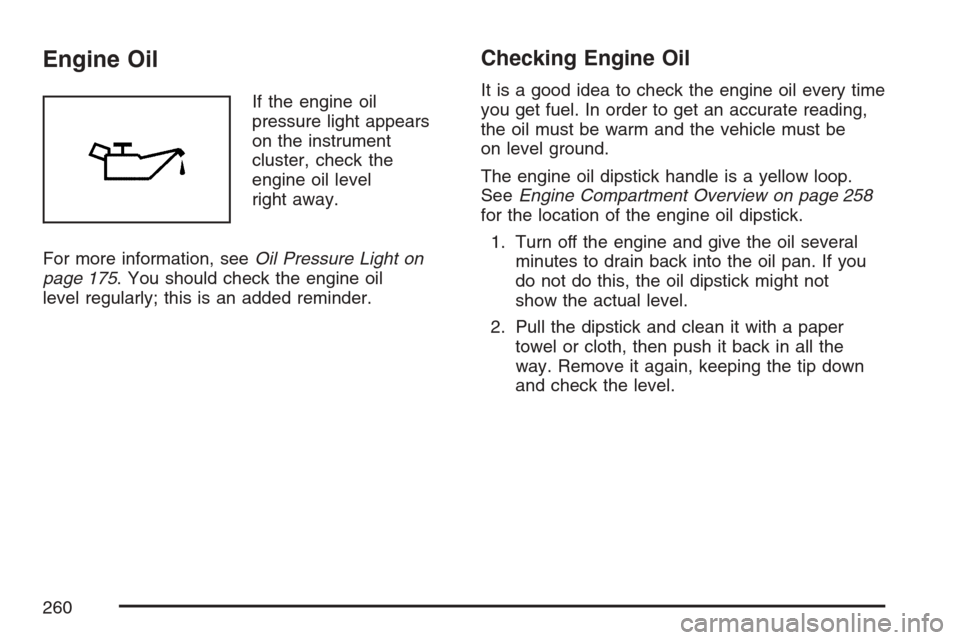
Engine Oil
If the engine oil
pressure light appears
on the instrument
cluster, check the
engine oil level
right away.
For more information, seeOil Pressure Light on
page 175. You should check the engine oil
level regularly; this is an added reminder.
Checking Engine Oil
It is a good idea to check the engine oil every time
you get fuel. In order to get an accurate reading,
the oil must be warm and the vehicle must be
on level ground.
The engine oil dipstick handle is a yellow loop.
SeeEngine Compartment Overview on page 258
for the location of the engine oil dipstick.
1. Turn off the engine and give the oil several
minutes to drain back into the oil pan. If you
do not do this, the oil dipstick might not
show the actual level.
2. Pull the dipstick and clean it with a paper
towel or cloth, then push it back in all the
way. Remove it again, keeping the tip down
and check the level.
260
Page 308 of 422

Bias Ply Tire:A pneumatic tire in which the plies
are laid at alternate angles less than 90 degrees
to the centerline of the tread.
Cold Tire Pressure:The amount of air pressure in
a tire, measured in pounds per square inch (psi) or
kilopascals (kPa) before a tire has built up heat
from driving. SeeInflation - Tire Pressure on
page 311.
Curb Weight:This means the weight of a motor
vehicle with standard and optional equipment
including the maximum capacity of fuel, oil, and
coolant, but without passengers and cargo.
DOT Markings:A code molded into the sidewall
of a tire signifying that the tire is in compliance
with the U.S. Department of Transportation (DOT)
motor vehicle safety standards. The DOT code
includes the Tire Identification Number (TIN),
an alphanumeric designator which can also identify
the tire manufacturer, production plant, brand,
and date of production.
GVWR:Gross Vehicle Weight Rating.
SeeLoading Your Vehicle on page 236.GAWR FRT:Gross Axle Weight Rating for the
front axle. SeeLoading Your Vehicle on page 236.
GAWR RR:Gross Axle Weight Rating for the
rear axle. SeeLoading Your Vehicle on page 236.
Intended Outboard Sidewall:The side of an
asymmetrical tire, that must always face outward
when mounted on a vehicle.
Kilopascal (kPa):The metric unit for air pressure.
Light Truck (LT-Metric) Tire:A tire used on
light duty trucks and some multipurpose passenger
vehicles.
Load Index:An assigned number ranging from
1 to 279 that corresponds to the load carrying
capacity of a tire.
Maximum In�ation Pressure:The maximum
air pressure to which a cold tire may be inflated.
The maximum air pressure is molded onto the
sidewall.
308
Page 311 of 422

In�ation - Tire Pressure
Tires need the correct amount of air pressure to
operate effectively.
Notice:Do not let anyone tell you that
under-in�ation or over-in�ation is all right.
It is not. If your tires do not have enough air
(under-in�ation), you can get the following:
Too much �exing
Too much heat
Tire overloading
Premature or irregular wear
Poor handling
Reduced fuel economy
If your tires have too much air (over-in�ation),
you can get the following:
Unusual wear
Poor handling
Rough ride
Needless damage from road hazardsA vehicle specific tire and loading information
label is attached to your vehicle. This label shows
your vehicle’s original equipment tires and the
correct inflation pressures for your tires when they
are cold. The recommended cold tire inflation
pressure, shown on the label, is the minimum
amount of air pressure needed to support
your vehicle’s maximum load carrying capacity.
For additional information regarding how much
weight your vehicle can carry, and an example
of the tire and loading information label, see
Loading Your Vehicle on page 236. How you load
your vehicle affects vehicle handling and ride
comfort, never load your vehicle with more weight
than it was designed to carry.
When to Check
Check your tires once a month or more. Do not
forget to check the compact spare tire. For
additional information regarding the compact spare
tire, seeCompact Spare Tire on page 334.
311
Page 313 of 422

As an added safety
feature, your vehicle
has been equipped
with a tire pressure
monitoring system
(TPMS) that illuminates
a low tire pressure
telltale when one
or more of your tires
is significantly
under-inflated.
Accordingly, when the low tire pressure telltale
illuminates, you should stop and check your tires
as soon as possible, and inflate them to the
proper pressure. Driving on a significantly
under-inflated tire causes the tire to overheat and
can lead to tire failure. Under-inflation also
reduces fuel efficiency and tire tread life, and may
affect the vehicle’s handling and stopping ability.
Please note that the TPMS is not a substitute for
proper tire maintenance, and it is the driver’s
responsibility to maintain correct tire pressure, even
if under-inflation has not reached the level to trigger
illumination of the TPMS low tire pressure telltale.Your vehicle has also been equipped with a
TPMS malfunction indicator to indicate when the
system is not operating properly. The TPMS
malfunction indicator is combined with the low tire
pressure telltale. When the system detects a
malfunction, the telltale will flash for approximately
one minute and then remain continuously
illuminated. This sequence will continue upon
subsequent vehicle start-ups as long as the
malfunction exists.
When the malfunction indicator is illuminated, the
system may not be able to detect or signal low
tire pressure as intended. TPMS malfunctions may
occur for a variety of reasons, including the
installation of replacement or alternate tires or
wheels on the vehicle that prevent the TPMS from
functioning properly. Always check the TPMS
malfunction telltale after replacing one or more
tires or wheels on your vehicle to ensure that the
replacement or alternate tires and wheels allow
the TPMS to continue to function properly.
313
Page 373 of 422
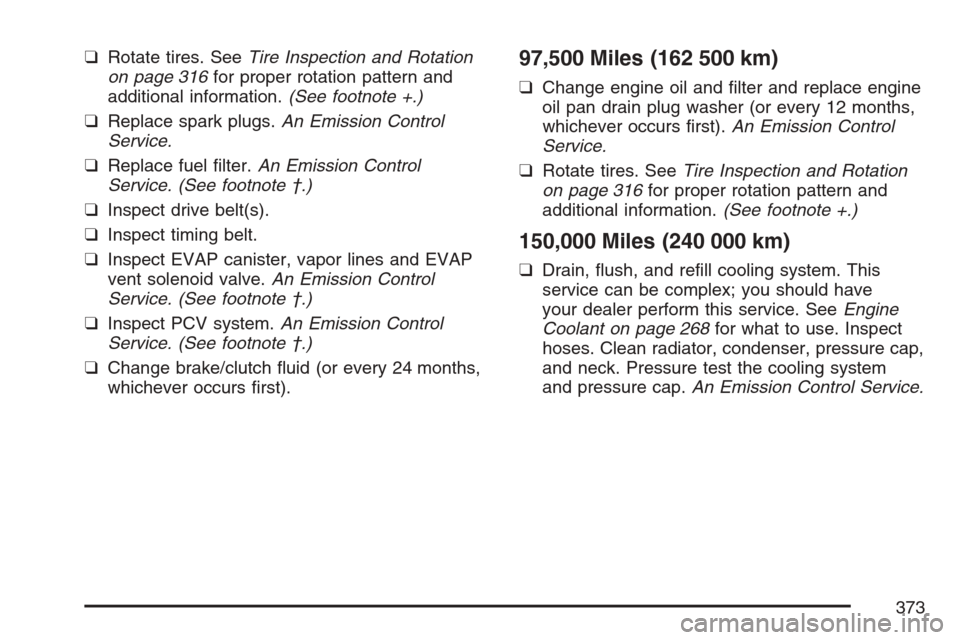
❑Rotate tires. SeeTire Inspection and Rotation
on page 316for proper rotation pattern and
additional information.(See footnote +.)
❑Replace spark plugs.An Emission Control
Service.
❑Replace fuel filter.An Emission Control
Service. (See footnote †.)
❑Inspect drive belt(s).
❑Inspect timing belt.
❑Inspect EVAP canister, vapor lines and EVAP
vent solenoid valve.An Emission Control
Service. (See footnote †.)
❑Inspect PCV system.An Emission Control
Service. (See footnote †.)
❑Change brake/clutch fluid (or every 24 months,
whichever occurs first).97,500 Miles (162 500 km)
❑Change engine oil and filter and replace engine
oil pan drain plug washer (or every 12 months,
whichever occurs first).An Emission Control
Service.
❑Rotate tires. SeeTire Inspection and Rotation
on page 316for proper rotation pattern and
additional information.(See footnote +.)
150,000 Miles (240 000 km)
❑Drain, flush, and refill cooling system. This
service can be complex; you should have
your dealer perform this service. SeeEngine
Coolant on page 268for what to use. Inspect
hoses. Clean radiator, condenser, pressure cap,
and neck. Pressure test the cooling system
and pressure cap.An Emission Control Service.
373
Page 374 of 422
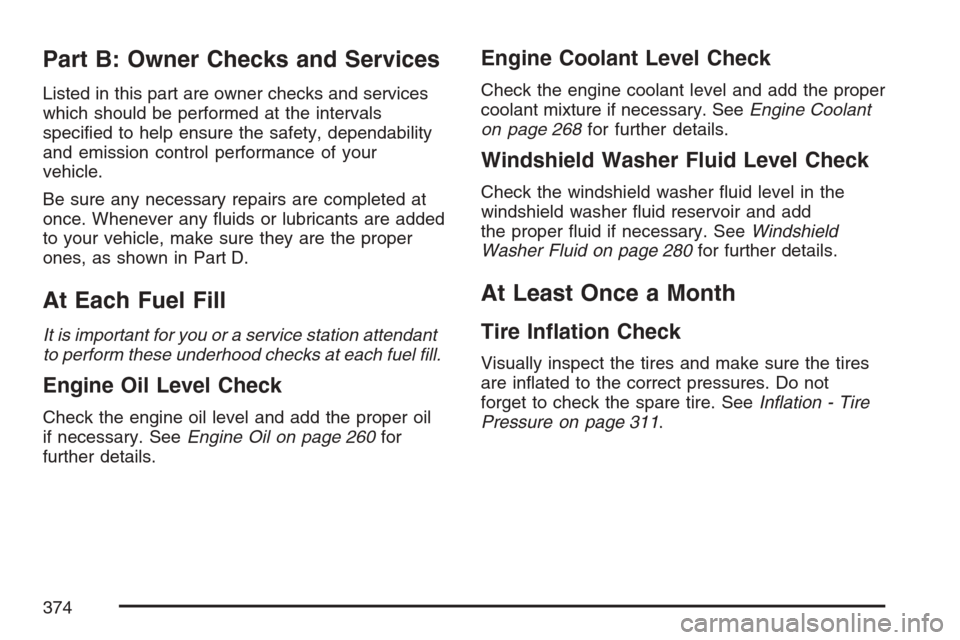
Part B: Owner Checks and Services
Listed in this part are owner checks and services
which should be performed at the intervals
specified to help ensure the safety, dependability
and emission control performance of your
vehicle.
Be sure any necessary repairs are completed at
once. Whenever any fluids or lubricants are added
to your vehicle, make sure they are the proper
ones, as shown in Part D.
At Each Fuel Fill
It is important for you or a service station attendant
to perform these underhood checks at each fuel fill.
Engine Oil Level Check
Check the engine oil level and add the proper oil
if necessary. SeeEngine Oil on page 260for
further details.
Engine Coolant Level Check
Check the engine coolant level and add the proper
coolant mixture if necessary. SeeEngine Coolant
on page 268for further details.
Windshield Washer Fluid Level Check
Check the windshield washer fluid level in the
windshield washer fluid reservoir and add
the proper fluid if necessary. SeeWindshield
Washer Fluid on page 280for further details.
At Least Once a Month
Tire In�ation Check
Visually inspect the tires and make sure the tires
are inflated to the correct pressures. Do not
forget to check the spare tire. SeeInflation - Tire
Pressure on page 311.
374
Page 415 of 422
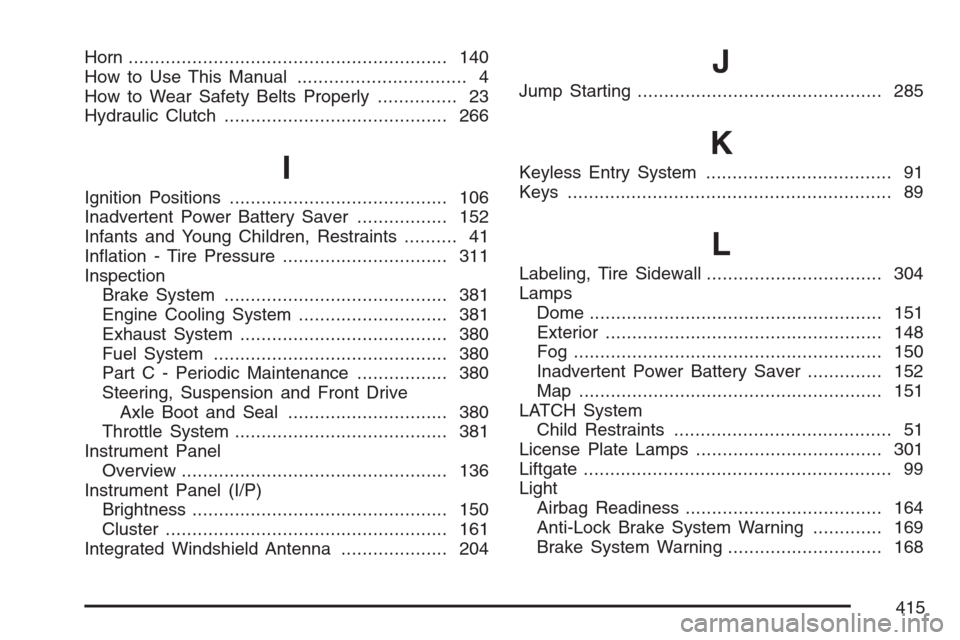
Horn............................................................ 140
How to Use This Manual................................ 4
How to Wear Safety Belts Properly............... 23
Hydraulic Clutch.......................................... 266
I
Ignition Positions......................................... 106
Inadvertent Power Battery Saver................. 152
Infants and Young Children, Restraints.......... 41
Inflation - Tire Pressure............................... 311
Inspection
Brake System.......................................... 381
Engine Cooling System............................ 381
Exhaust System....................................... 380
Fuel System............................................ 380
Part C - Periodic Maintenance................. 380
Steering, Suspension and Front Drive
Axle Boot and Seal.............................. 380
Throttle System........................................ 381
Instrument Panel
Overview.................................................. 136
Instrument Panel (I/P)
Brightness................................................ 150
Cluster..................................................... 161
Integrated Windshield Antenna.................... 204
J
Jump Starting.............................................. 285
K
Keyless Entry System................................... 91
Keys............................................................. 89
L
Labeling, Tire Sidewall................................. 304
Lamps
Dome....................................................... 151
Exterior.................................................... 148
Fog .......................................................... 150
Inadvertent Power Battery Saver.............. 152
Map ......................................................... 151
LATCH System
Child Restraints......................................... 51
License Plate Lamps................................... 301
Liftgate.......................................................... 99
Light
Airbag Readiness..................................... 164
Anti-Lock Brake System Warning............. 169
Brake System Warning............................. 168
415